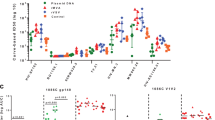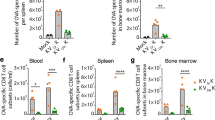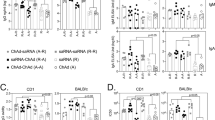Abstract
Two plasmid DNA vaccines, encoding either products that are retained in the cytosol and degraded in the proteasome (tVacs; hPSMAt), or secreted proteins (sVacs; hPSMAs) were evaluated for stimulation of cytotoxic cell or antibody responses. Immunization with both vectors led to generation of cell cytotoxicity providing granulocyte-macrophage colony-stimulating factor was administered with the vaccine. Spleen cells from animals immunized with hPSMAt demonstrated stronger cytotoxicity to the target cells. Priming with a vector that encoded a xenogeneic protein (hPSMAt; ‘xenogeneic’ construct) and boosting with a vector that encoded an autologous protein (rPSMAt; ‘autologous’ construct) gave the best protection against tumor challenge. Immunization with tVacs did not lead to formation of antibodies to the target protein as detected by Western blot or ELISA, while immunization with sVacs or with the protein did. Antibodies were of mixed Th1–Th2 isotype. Priming with tVacs and boosting with protein also resulted in antibody formation, but in this case the antibodies were from the cytotoxic, Th1 isotype. The best strategy to obtain a strong cellular cytotoxic response, therefore, seems to be gene-based vaccinations with tVacs, priming with the ‘xenogeneic’ and boosting with the ‘autologous’ constructs. When cytotoxic antibody production is the goal, priming should be performed with the tVacs while boosting with the protein.
This is a preview of subscription content, access via your institution
Access options
Subscribe to this journal
Receive 12 print issues and online access
$259.00 per year
only $21.58 per issue
Buy this article
- Purchase on Springer Link
- Instant access to full article PDF
Prices may be subject to local taxes which are calculated during checkout






Similar content being viewed by others
References
Epstein JE, Charoenvit Y, Kester KE, Wang R, Newcomer R, Fitzpatrick S et al. Safety, tolerability, and antibody responses in humans after sequential immunization with a PfCSP DNA vaccine followed by the recombinant protein vaccine RTS,S/AS02A. Vaccine 2004; 22: 1592–1603.
Boyd D, Hung CF, Wu TC . DNA vaccines for cancer. IDrugs 2003; 6: 1155–1164.
Srinivasan R, Wolchok JD . Tumor antigens for cancer immunotherapy: therapeutic potential of xenogeneic DNA vaccines. J Transl Med 2004; 2: 12.
Mincheff M, Tchakarov S, Zoubak S, Loukinov D, Botev C, Altankova I et al. Naked DNA and adenoviral immunizations for immunotherapy of prostate cancer: a phase I/II clinical trial. Eur Urol 2000; 38: 208–217.
Gulley J, Chen AP, Dahut W, Arlen PM, Bastian A, Steinberg SM et al. Phase I study of a vaccine using recombinant vaccinia virus expressing PSA (rV-PSA) in patients with metastatic androgen-independent prostate cancer. Prostate 2002; 53: 109–117.
Pavlenko M, Roos AK, Lundqvist A, Palmborg A, Miller AM, Ozenci V et al. A phase I trial of DNA vaccination with a plasmid expressing prostate-specific antigen in patients with hormone-refractory prostate cancer. Br J Cancer 2004; 91: 688–694.
Pardoll D . T cells and tumours. Nature 2001; 411: 1010–1012.
Rodriguez A, Regnault A, Kleijmeer M, Ricciardi-Castagnoli P, Amigorena S . Selective transport of internalized antigens to the cytosol for MHC class I presentation in dendritic cells. Nat Cell Biol 1999; 1: 362–368.
Mincheff M, Zoubak S, Altankova I, Tchakarov S, Makogonenko Y, Botev C et al. Human dendritic cells genetically engineered to express cytosolically retained fragment of prostate-specific membrane antigen prime cytotoxic T-cell responses to multiple epitopes. Cancer Gene Ther 2003; 10: 907–917.
Silver DA, Pellicer I, Fair WR, Heston WD, Cordon-Cardo C . Prostate-specific membrane antigen expression in normal and malignant human tissues. Clin Cancer Res 1997; 3: 81–85.
Shneider BL, Thevananther S, Moyer MS, Walters HC, Rinaldo P, Devarajan P et al. Cloning and characterization of a novel peptidase from rat and human ileum. J Biol Chem 1997; 272: 31006–31015.
Halsted CH, Ling E, Luthi-Carter R, Villanueva JA, Gardner JM, Coyle JT . Folylpoly-gamma-glutamate carboxypeptidase from pig jejunum. Molecular characterization and relation to glutamate carboxypeptidase II. J Biol Chem 2000; 275: 30746.
Chang SS, Bander NH, Heston WD . Monoclonal antibodies: will they become an integral part of the evaluation and treatment of prostate cancer – focus on prostate-specific membrane antigen? Curr Opin Urol 1999; 9: 391–395.
Chang SS, Gaudin PB, Reuter VE, O'Keefe DS, Bacich DJ, Heston WD et al. Prostate-specific membrane antigen: much more than a prostate cancer marker. Mol Urol 1999; 3: 313–320.
Beckett ML, Cazares LH, Vlahou A, Schellhammer PF, Wright Jr GL . Prostate-specific membrane antigen levels in sera from healthy men and patients with benign prostate hyperplasia or prostate cancer. Clin Cancer Res 1999; 5: 4034–4040.
Murphy GP, Kenny GM, Ragde H, Wolfert RL, Boynton AL, Holmes EH et al. Measurement of serum prostate-specific membrane antigen, a new prognostic marker for prostate cancer. Urology 1998; 51 (Suppl 5A): 89–97.
Uria JA, Velasco G, Santamaria I, Ferrando A, Lopez-Otin C . Prostate-specific membrane antigen in breast carcinoma. Lancet 1997; 349: 1601.
Israeli RS, Powell CT, Corr JG, Fair WR, Heston WD . Expression of the prostate-specific membrane antigen. Cancer Res 1994; 54: 1807–1811.
Pinto JT, Suffoletto BP, Berzin TM, Qiao CH, Lin S, Tong WP et al. Prostate-specific membrane antigen: a novel folate hydrolase in human prostatic carcinoma cells. Clin Cancer Res 1996; 2: 1445–1451.
Mincheff M, Zoubak S . Gene-based vaccines for immunotherapy of prostate cancer – lessons from the past. Gene Ther Mol Biol 2004; 8: 465–474.
Fong L, Ruegg CL, Brockstedt D, Engleman EG, Laus R. Induction of tissue-specific autoimmune prostatitis with prostatic acid phosphatase immunization: implications for immunotherapy of prostate cancer. J Immunol 1997; 159: 3113–3117.
Fong L, Brockstedt D, Benike C, Breen JK, Strang G, Ruegg CL et al. Dendritic cell-based xenoantigen vaccination for prostate cancer immunotherapy. J Immunol 2001; 167: 7150–7156.
Wolchok JD, Gregor PD, Nordquist LT, Slovin SF, Scher HI . DNA vaccines: an active immunization strategy for prostate cancer. Semin Oncol 2003; 30: 659–666.
Gregor PD, Wolchok JD, Ferrone CR, Buchinshky H, Guevara-Patino JA, Perales MA et al. CTLA-4 blockade in combination with xenogeneic DNA vaccines enhances T-cell responses, tumor immunity and autoimmunity to self antigens in animal and cellular model systems. Vaccine 2004; 22: 1700–1708.
Barinka C, Rinnova M, Sacha P, Rojas C, Majer P, Slusher BS et al. Substrate specificity, inhibition and enzymological analysis of recombinant human glutamate carboxypeptidase II. J Neurochem 2002; 80: 477–487.
Matzinger P . The JAM test. A simple assay for DNA fragmentation and cell death. J Immunol Methods 1991; 145: 185–192.
Taglietti M . Vaccine adjuvancy: a new potential area of development for GM-CSF. Adv Exp Med Biol 1995; 378: 565–569.
Mincheff M, Zoubak S, Altankova I, Tchakarov S, Pogribnyy P, Makogonenko Y et al. Depletion of CD25+ cells from human T-cell enriched fraction eliminates immunodominance during priming with dendritic cells genetically modified to express a secreted protein. Cancer Gene Ther 2005; 12: 185–197.
Klinman DM, Yi AK, Beaucage SL, Conover J, Krieg AM . CpG motifs present in bacteria DNA rapidly induce lymphocytes to secrete interleukin 6, interleukin 12, and interferon gamma. Proc Natl Acad Sci USA 1996; 93: 2879–2883.
Klinman DM, Yamshchikov G, Ishigatsubo Y . Contribution of CpG motifs to the immunogenicity of DNA vaccines. J Immunol 1997; 158: 3635–3639.
Klinman DM, Barnhart KM, Conover J . CpG motifs as immune adjuvants. Vaccine 1999; 17: 19–25.
Krieg AM, Love-Homan L, Yi AK, Harty JT . CpG DNA induces sustained IL-12 expression in vivo and resistance to Listeria monocytogenes challenge. J Immunol 1998; 161: 2428–2434.
Krieg AM, Yi AK, Schorr J, Davis HL . The role of CpG dinucleotides in DNA vaccines. Trends Microbiol 1998; 6: 23–27.
Krieg AM . Mechanisms and applications of immune stimulatory CpG oligodeoxynucleotides. Biochim Biophys Acta 1999; 1489: 107–116.
Krieg AM, Yi AK, Hartmann G . Mechanisms and therapeutic applications of immune stimulatory cpG DNA. Pharmacol Ther 1999; 84: 113–120.
Perales MA, Fantuzzi G, Goldberg SM, Turk MJ, Mortazavi F, Busam K et al. GM-CSF DNA induces specific patterns of cytokines and chemokines in the skin: implications for DNA vaccines. Cytokines Cell Mol Ther 2002; 7: 125–133.
Tsuchiya Y, Igarashi M, Suzuki R, Kumagai K . Production of colony-stimulating factor by tumor cells and the factor-mediated induction of suppressor cells. J Immunol 1988; 141: 699–708.
Pasquini S, Xiang Z, Wang Y, He Z, Deng H, Blaszczyk-Thurin M et al. Cytokines and costimulatory molecules as genetic adjuvants. Immunol Cell Biol 1997; 75: 397–401.
Simmons SJ, Tjoa BA, Rogers M, Elgamal A, Kenny GM, Ragde H et al. GM-CSF as a systemic adjuvant in a phase II prostate cancer vaccine trial. Prostate 1999; 39: 291–297.
Drew DR, Lightowlers M, Strugnell RA . Humoral immune responses to DNA vaccines expressing secreted, membrane bound and non-secreted forms of the Tania ovis 45W antigen. Vaccine 2000; 18: 2522–2532.
Haddad D, Liljeqvist S, Stahl S, Andersson I, Perlmann P, Berzins K et al. Comparative study of DNA-based immunization vectors: effect of secretion signals on the antibody responses in mice. FEMS Immunol Med Microbiol 1997; 18: 193–202.
Ma X, Forns X, Gutierrez R, Mushahwar IK, Wu T, Payette PJ et al. DNA-based vaccination against hepatitis C virus (HCV): effect of expressing different forms of HCV E2 protein and use of CpG-optimized vectors in mice. Vaccine 2002; 20: 3263–3271.
Strasser JE, Arnold RL, Pachuk C, Higgins TJ, Bernstein DI . Herpes simplex virus DNA vaccine efficacy: effect of glycoprotein D plasmid constructs. J Infect Dis 2000; 182: 1304–1310.
Wang L, Menting JG, Black CG, Stowers A, Kaslow DC, Hoffman SL et al. Differences in epitope recognition, isotype and titer of antisera to Plasmodium falciparum merozoite surface protein 4 raised by different modes of DNA or protein immunization. Vaccine 2000; 19: 816–824.
Haddad D, Liljeqvist S, Stahl S, Hansson M, Perlmann P, Ahlborg N et al. Characterization of antibody responses to a Plasmodium falciparum blood-stage antigen induced by a DNA prime/protein boost immunization protocol. Scand J Immunol 1999; 49: 506–514.
Haddad D, Liljeqvist S, Stahl S, Perlmann P, Berzins K, Ahlborg N . Differential induction of immunoglobulin G subclasses by immunization with DNA vectors containing or lacking a signal sequence. Immunol Lett 1998; 61: 201–204.
Higgins TJ, Herold KM, Arnold RL, McElhiney SP, Shroff KE, Pachuk CJ et al. Plasmid DNA-expressed secreted and nonsecreted forms of herpes simplex virus glycoprotein D2 induce different types of immune responses. J Infect Dis 2000; 182: 1311–1320.
McDevitt MR, Barendswaard E, Ma D, Lai L, Curcio MJ, Sgouros G et al. An alpha-particle emitting antibody ([213Bi]J591) for radioimmunotherapy of prostate cancer. Cancer Res 2000; 60: 6095–6100.
Nanus DM, Milowsky MI, Kostakoglu L, Smith-Jones PM, Vallabahajosula S, Goldsmith SJ et al. Clinical use of monoclonal antibody HuJ591 therapy: targeting prostate specific membrane antigen. J Urol 2003; 170 (6 Part 2): S84–S88; discussion S88–S89.
Bander NH, Nanus DM, Milowsky MI, Kostakoglu L, Vallabahajosula S, Goldsmith SJ et al. Targeted systemic therapy of prostate cancer with a monoclonal antibody to prostate-specific membrane antigen. Semin Oncol 2003; 30: 667–676.
Huang X, Bennett M, Thorpe PE . Anti-tumor effects and lack of side effects in mice of an immunotoxin directed against human and mouse prostate-specific membrane antigen. Prostate 2004; 61: 1–11.
Kuratsukuri K, Wang CY, Sone T, Nishisaka N, Jones RF, Haas GP . Induction of antibodies against prostate-specific membrane antigen (PSMA) by vaccination with a PSMA DNA vector. Eur Urol 2002; 42: 67–73.
Acknowledgements
This work was supported in part by Grant N00014-00-1-0787 from the Office of Naval Research. This work was also supported in part by Award No DAMD17-02-1-0239. The US Army Medical Research Acquisition Activity, 820 Chandler Street, Fort Detrick, MD 21702-5014 is the awarding and administering acquisition office.
Author information
Authors and Affiliations
Corresponding author
Additional information
The content of the information does not necessarily reflect the position or the policy of the Government, and no official endorsement should be inferred. For purpose of this article, information includes news releases, articles, manuscripts, brochures, advertisements, still and motion pictures, speeches, trade association proceedings etc.
Rights and permissions
About this article
Cite this article
Mincheff, M., Zoubak, S. & Makogonenko, Y. Immune responses against PSMA after gene-based vaccination for immunotherapy – A: results from immunizations in animals. Cancer Gene Ther 13, 436–444 (2006). https://doi.org/10.1038/sj.cgt.7700914
Received:
Revised:
Accepted:
Published:
Issue Date:
DOI: https://doi.org/10.1038/sj.cgt.7700914
Keywords
This article is cited by
-
DNA vaccination for prostate cancer, from preclinical to clinical trials - where we stand?
Genetic Vaccines and Therapy (2012)



